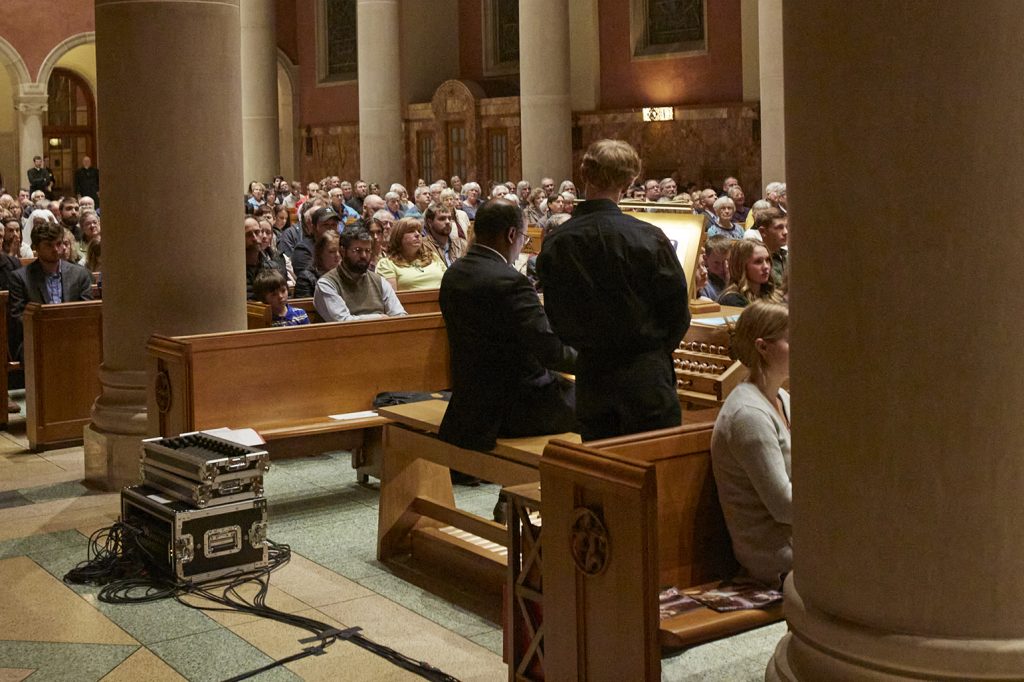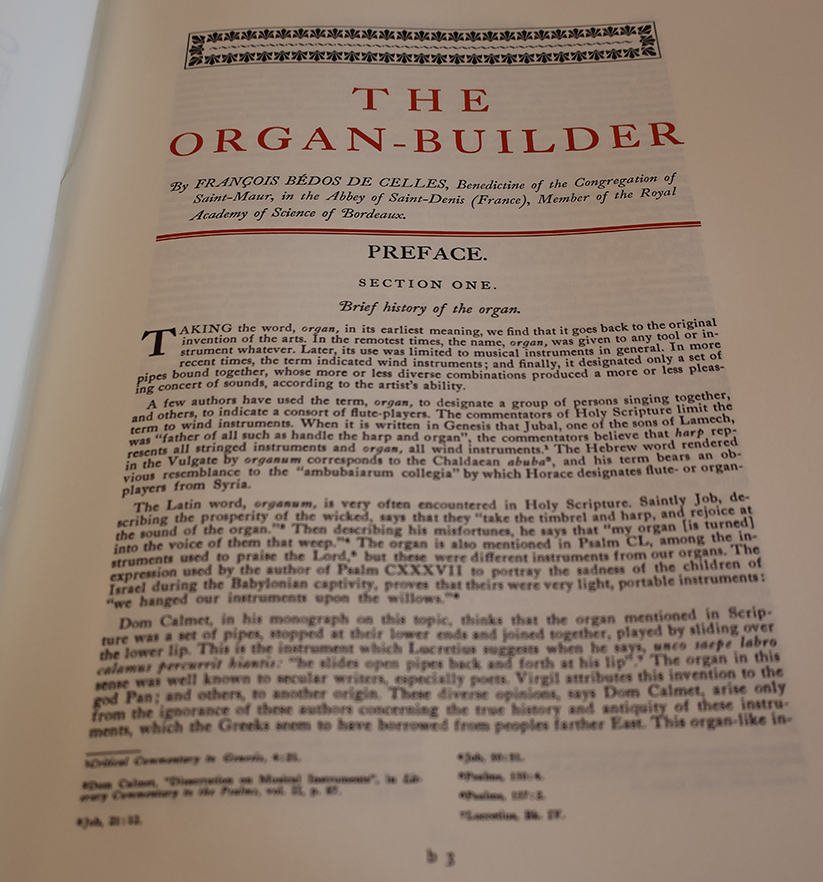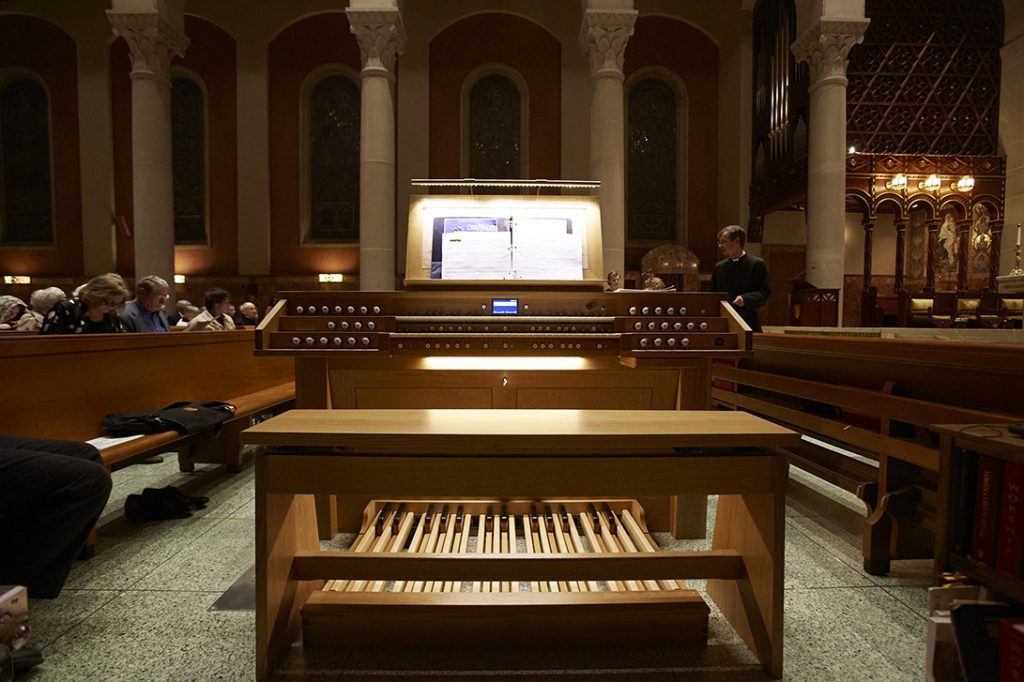Pasi Opus 29: More Stories About MTSM’s New Pipe Organ

Dr. Kola Owolabi performs on Pasi Opus 29 at the organ’s dedication recital in the Chapel of St. Gregory the Great on Sunday, November 12, 2023
The stories below was originally published in The Athenaeum, MTSM’s bi-annual magazine. The Athenaeum is published twice a year for alumni, patrons and friends of Mount St. Mary’s Seminary & School of Theology. To be added to the mailing list, contact: Heidi Walsh at 513.233.6159 or hwalsh@athenaeum.edu.
Pasi Thankful for Time at MTSM, Onto Next Project

Martin Pasi (left) and The Very Rev. Anthony R. Brausch following the blessing and dedication for Pasi Opus 29 on October 8, 2023
The Pasi Opus 29 organ blessing and dedication on October 8 also marked the end of Martin Pasi’s time as a guest at Mount St. Mary’s Seminary & School of Theology. Pasi arrived at MTSM on July 13 with the pieces to what would eventually become the organ now in the Chapel of St. Gregory the Great. For three months, Pasi made the Chapel his office and MTSM his home away from home.
“Working with Dr. (Mary Catherine) Levri and Fr. (Anthony) Brausch before we got here was enjoyable,” Pasi said. “Then we arrived and got to meet the various priests and staff and then the seminarians when they returned, I have made a lot of friends here. The people here have made it feel like a home away from home.”
There is no rest for Pasi though. The building of Pasi Opus 29 concluded his time based in Roy, Washington and he is now taking his work to a new place, where he will look to build a lasting legacy. He is now based at the College of Saint Benedict & Saint John’s University in Collegeville, Minnesota having merged his Pasi Organ Builders with Saint John’s Abbey’s wood-working shop to create Abbey Organ Builders.
“The idea came about when we built an organ at Saint John’s (Pasi Opus 27, completed in 2020),” Pasi noted. “I was there for seven months, it was a large project and we had the pandemic during it. It allowed me to slow down and gave me more time to contemplate and think about what to do with my company, both with our materials and the wealth of knowledge and expertise that we have. I approached the monks about the idea, and they eventually got on board and pursued the idea.”
On October 17, CSB/SJU officially blessed and dedicated the new Saint John’s Abbey Organ Builders workshop. Their first commission (Opus 1) will be for St. Michael the Archangel Parish in Leawood, Kansas. Their Director of Worship & Scared Arts, Dr. Kevin Vogt, was the speaker at MTSM’s Fall Lecture and was the Music Director at St. Cecilia Cathedral in Omaha, Nebraska where Pasi Opus 14 was commissioned.
While continuing to build pipe-organs is what Pasi plans to do, he is looking forward to helping train the next generation of organ builders.
“I just have to bring my knowledge, hands and brain,” Pasi concluded. “There are not a lot of organ builders in the world, we need people in the future who will build and take care of organs.”
Pasi Gifts Organ Building Book to Maly Library

A page of The Organ-Builder by Dom Bedos de Celles
The brand-new pipe organ for the Chapel of St. Gregory the Great was not the only thing Martin Pasi has left to MTSM. He has gifted the Seminary a translated copy of L’art du facteur d’orgues (The Art of the Organ-Builder). Written by Dom Bédos de Celles, a French Benedictine monk, between 1766 and 1778 as part of the French Academy of Sciences Descriptions des Arts et Métiers (Descriptions of Arts and Trades), it is filled with writings and illustrations referenced by many organ-builders over the years, including Pasi himself.
“The book is a must-have for organ builders,” Pasi said. “There is a wealth of information that does not exist in other books in such a complete way. The organ building of the time was of a very high standard. I thought that a place like this with a library and a place that educates priests, this book would be something worthwhile to live here. I wanted to give something to the community here. It made sense and will be here for a long time.”
The book is now on display in the Maly Library at MTSM and will become part of the library’s Rare Books Collection.
“An Organ Rooted in History, but a Modern Organ”

Pasi Opus 29 uses technology called proportional key action for the console to communicate with the pipes
“We set out to build an organ that was rooted in history, but we created a modern organ.”
What does organ builder Martin Pasi mean with that statement? Pasi Opus 29 at MTSM is fitted with a proportional key action system, which uses electro-magnet circuits to communicate with the pipes of the organ as if it was a mechanical connection. This is imperative for the organ in the Chapel of St. Gregory the Great, with the pipes a long distance away from the console.
“When I was at Notre Dame, I was blessed to be trained on wonderful, world-class mechanical-action organs that teach players to connect with the pipes and sensitivity on the keys,” Dr. Mary Catherine Levri, MTSM Music Director said. “I have had warm memories of that time when playing Pasi Opus 29, the organ is teaching me how to play it and to use my ears to respond.”
In addition, the organ has a built-in digital interface from Rieger Orgelbau out of Schwarzach, Austria. Should MTSM ever need work done on the digital components of Pasi Opus 29, the people at Rieger can remotely log into the digital interface of the organ and see what is going on.
“Pasi Opus 29 has a pretty hardy digital component,” Dr. Levri said. “The digital interface is a lot like remotely logging into a computer. Having the digital components allows the organ to behave like a mechanical-action organ, which are at the heart and soul of organ-building history.”
This was a unique, but not unprecedented project for Pasi, who had previously done work with proportional key action systems when completing Pasi Opus 19 for the Co-Cathedral of the Sacred Heart in Houston, Texas.
“I have always been known to like a challenge,” Pasi reflected. “Things came to me easily because of the way the people at MTSM talked to me about the project, they had a lot of trust in me and wanted me to do what made the most sense.”
In his original proposal to MTSM to build the organ in the Chapel of St. Gregory the Great, Pasi said ‘careful design and construction promises longevity measured in centuries’. The work to install the proportional key action ensures the seminary has an organ that will be ready for the changing times.
“The technology will serve the organ well,” Dr. Levri concluded.